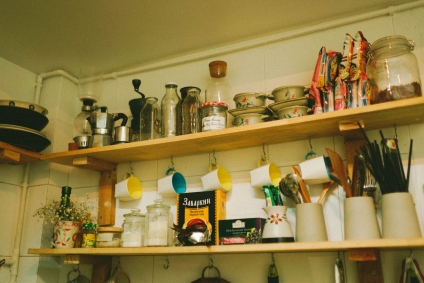Divide (Literally) and Mindfully Conquer

When I was 14 years old my mother suggested that I reorganize our utility closet. Even at that tender age, I realized that this tiny little room would never stay organized unless I had some way to divide and permanently separate items. The room was about five-by-five feet with no door, it simply had an entrance way, downstairs next to the laundry room. As you entered, to the right there were five built-in shelves; to the left there were a couple of clothing hooks hung in a single row for coats and jackets.
Although it was a tiny room, it was a mess beyond reason and hope. The room served as our household catchall and contained tennis balls, wires, excess telephone cords, gloves, mittens, nuts and bolts, flashlights, batteries, and some objects that I couldn’t figure out for the life of me!
Grouping Like with Like
I hunted throughout the house to find empty shoeboxes and was able to gather about six or seven, which seemed like enough. I returned to the utility closet and began grouping like items together. I started with the middle shelf because it was the easiest to see and reach. There were enough stray tennis balls, racket balls, ping-pong balls, and golf balls to fit in one large shoebox. Then I used another shoebox to house wires, phone cords, extensions, extra light switches, wall outlets, and other small electrical stuff.
Since I didn’t have all the shoeboxes I needed, I placed mittens, gloves, and scarves neatly in between the “ball” box and the “electrical” box. Using another shoebox, I housed extra door stoppers, furniture savers (small, circular rubber mats that go under table legs and couches to preserve the rugs), dusting items, a whisk broom, and other stuff that didn’t seem to fit anyplace else.
In the next space, I assembled cans and canisters that would remain upright and in place, such as insect spray, three in one oil, poison ivy lotion, plant food sprayers, and other such items. Once again, I did not use a shoebox; instead I let the borders between shoes boxes serve as a compartment of sorts. Now the entire shelf, which consisted of five compartments, was complete. The shelf was visually pleasing if I say so myself and a whole lot more organized than before I had started. I went on to tackle the other shelves in the same manner and spirit.
Spacing and Placing
In the space between the floor and the bottom of the first shelf I placed the largest items – those which, if they were to fall, would cause a ruckus. On higher shelves I placed the lightest items, those seldom used, and perhaps most importantly, those that could easily be seen by a shorter person such as my mother.
Some of the items I encountered didn’t belong in this utility closet at all. No surprise about that. I relocated such items to their proper homes in the garage, the laundry room, the kitchen, or the back deck. Some items didn’t merit retention so I chucked ’em. Some items were unnecessary duplicates, so I gave them away.
When the project was complete, I stood back and examined the results. The closet that had been a total mess was now neat, functional, and (dare I say it?) roomy! The actual time to rearrange each shelf was no more than a few minutes. Re-allocating items best suited in other locations throughout the house took several more minutes, but this was not a difficult task.
Years later when I was a senior in high school and then a college student, my organizational efforts in this particular room continued to prevail – no lie! Literally dividing up the items and creating permanent separations was the key. Sure, a couple of items were out of place, and the compartments on each shelf weren’t quite so neat. Also some new items had been put in the closet (presumably for me to come by and integrate!)
Still, six years after my initial efforts, even in the face of the entropy that predictably transpires in a household of six people, the utility closet essentially remained organized. My organizational artistry had prevailed.
Manageable for the Long Haul
The insights I gained from this task stayed with me over the following decades: If you have the right containers, dividers, and tools at your disposal, the physical organization of a space or place in your life is entirely manageable. You can prevail. You can keep your possessions in order and attain greater peace of mind. You can find your possessions when you need them. You can even show people your marvelous work.
About the Author

Jeff Davidson, the world’s only holder of the title “The Work-Life Balance Expert®” as awarded by the U.S. Patent and Trademark Office, is the premier thought leader on work-life balance, harmony, and integration. Jeff speaks to organizations that seek to enhance their overall productivity by improving the effectiveness of their people. He is author of Everyday Project Management, Breathing Space, and Simpler Living. Visit www.BreathingSpace.com.
If you enjoyed this article, sign up below for the Blooming Lotus Newsletter and we’ll notify you when the next article is released:





0 Comments